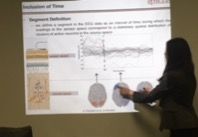Functional Neuroimaging Techniques and Applications
Functional neuroimaging was the topic of the May 3 meeting of the New York–New Jersey Chapter of the Society for Applied Spectroscopy (NYSAS), which was held at Rutgers University in New Brunswick, New Jersey. The invited speaker was Professor Laleh Najafizadeh, who is an assistant professor and the director of the Integrated Systems and Neuroimaging Laboratory in the Department of Electrical and Computer Engineering (ECE) at Rutgers.
Functional neuroimaging was the topic of the May 3 meeting of the New York–New Jersey Chapter of the Society for Applied Spectroscopy (NYSAS), which was held at Rutgers University in New Brunswick, New Jersey. The invited speaker was Professor Laleh Najafizadeh, who is an assistant professor and the director of the Integrated Systems and Neuroimaging Laboratory in the Department of Electrical and Computer Engineering (ECE) at Rutgers.
Prof. Laleh Najafizadeh of the department of Electrical and Computer Engineering at Rutgers Univesrity presenting at the May 2018 meeting of the New York–New Jersey Chapter of the Society for Applied Spectroscopy.

Najafizadeh received her PhD degree from Georgia Institute of Technology in Atlanta and attended the University of Alberta in Canada and Isfahan University of Technology in Iran for her master’s and bachelor’s degrees. From 2010 to 2012 she was a postdoctoral research fellow at the National Institutes of Health (NIH), in Bethesda, Maryland, where she conducted research in the areas of neuroscience, functional brain imaging, and biophotonics. She has coauthored two book chapters and more than 90 peer-reviewed papers and conference proceedings and has received awards for her research.
The human brain is a highly complex dynamic system. Achieving a complete understanding of how its anatomical structure supports a diverse range of functions, such as action, perception, and cognition, is an ultimate goal of neuroscience, but is still far from reach. Toward this goal, noninvasive functional neuroimaging techniques are being used to obtain new insights about the mechanisms behind the brain functions, not only in healthy people but also in patients suffering from brain-related diseases including those with traumatic brain injuries (TBIs), autism spectrum disorder (ASD), and schizophrenia.
In her talk, Najafizadeh presented an overview of how the functionality of the brain can be monitored using two noninvasive imaging modalities: functional near-infrared (fNIR) spectroscopy and electroencephalography (EEG). The presentation demonstrated computational techniques developed to analyze recordings obtained using these two imaging modalities. The talk included highlights from recent projects including the use of fNIR spectroscopy to study brain activity in response to irritant-containing solutions in the mouth. Brain activity can now be monitored using wearable devices and this approach is being used for a wide range of applications including helping patients to overcome diseases and paralysis to neuromarketing. The goal is to better understand the relationships between structure, function, and behavior.
The meeting was attended by industrial partners, other university professors, and several retirees from the fields of spectroscopy, microscopy, and biopharmaceuticals. Debbie Peru coordinated the meeting on behalf of NYSAS and introduced the speaker. At the end of the presentation and following a question-and-answer session, Najafizadeh was presented with a custom-designed prism as a thank you from the group.
More information about the chapter and the schedule of meetings can be found at www.nysas.org.
New AI Model Accelerates Infrared Imaging for Protein Analysis, Study Reveals
May 7th 2025A new study led by Ayanjeet Ghosh of the University of Alabama presents a transformative approach to analyzing infrared (IR) imaging data, with promising implications for neurodegenerative disease research.